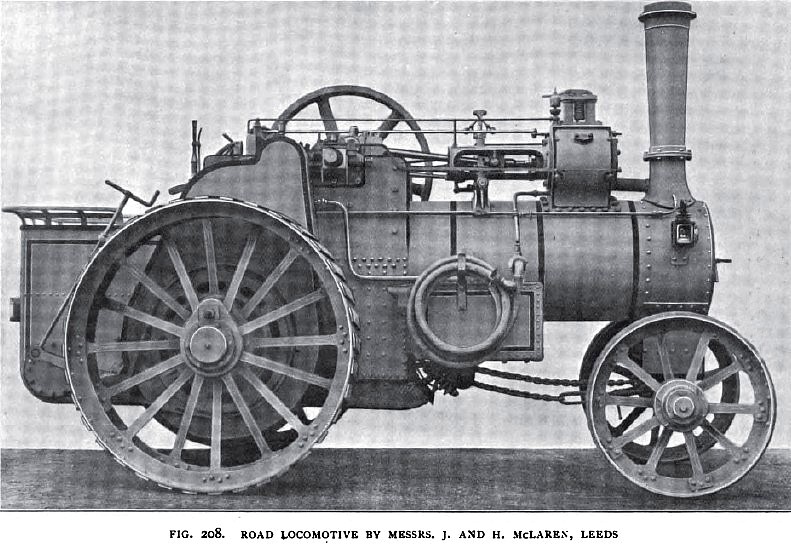|
Title: |
1904 Article-J. & H. McLaren, Steam Road Locomotive |
|
Source: |
English and American Steam Carriages and Traction Engines 1904 pg 339 |
|
Insert Date: |
8/19/2011 7:45:24 PM |
|
MESSRS. J. AND H. McLAREN — Some road locomotives, similar to the one illustrated by Fig. 208, have been shipped by Messrs. McLaren to South Africa. The engine has compound side-by-side cylinders of 7 in. and 11 in. diameter; it has developed 70 horse-power on the brake, and in an actual test hauled a load of 55 tons up an incline of 1 in 12. The fire-box is of extra size for burning inferior fuel. A distance of 12 miles can be traversed on bad roads with one tank full of water. The driving wheels are of great width, so as to travel over soft ground without sinking. All the shafts are of great strength. The engine is mounted at the firebox end on the spring arrangement as illustrated on chapter VII. Laminated springs also carry the front end of the engine. The steerage of the front wheels is often effected by an arrangement of worm and rack, so as to be positive in action, and without the back-lash inevitable with chain-steerage. This renders it more reliable in traveling along roads which are frequently mere shelves on mountain-sides, and where an accident to the steering-gear might involve a most serious accident. One of Messrs. McLaren’s traction engines, built for colonial requirements, has been used for wool cartage in New Zealand, and has traveled nearly 70,000 miles without a crack in the fire-box or the breaking of a spring; this shows that succeeded in adapting the engine to tasks it has to perform. Figs. 209 & 210 show one of McLaren’s traction engine boilers of the multi-tubular type. It is an excellent generator, and forms a support upon which the engine parts are bolted. The employment of traction engines for industrial purposes is extending. Mr. John McLaren gives some interesting particulars of work done, which are quoted. In the Sheffield district, a number of men, who call themselves “contractors”, have each acquired from three to a half dozen traction engines, and either let them out on hire by the day, or themselves undertake the moving of heavy loads. In this way, large quantities of flour, coal and other materials are daily sent to the outlying villages in the Peak district, which has hitherto been without any railway communication. One contractor is largely employed at iron and steel works, moving heavy articles such as armor-plates hammer-blocks and other weights, occasionally exceeding 50 tons. He is also employed in hauling by road boilers, spur-wheels, stern-posts and other bulky articles, which cannot conveniently be carried by rail. These are frequently taken long distances, such as to Newcastle, Liverpool, etc., without any hitch or trouble. Another contractor in the Peak district traverses a distance of 32 miles daily, with an 8 horsepower engine. The trip consists of a 16 mile journey to the railway station with the empty wagons, returning the same distance with a load of 13 tons of coal. The weight of the two wagons is 5½ tons, making a gross load of 18½ tons, exclusive of the weight of the engine. This performance has been maintained for several years, making an average o 192 miles per week. In summer weather, with good roads, the outward journey has been frequently made with a load of about 12 tons of limestone for road repairs. This involved a detour of several miles, which brought the average distance up to 205 miles a week. As an instance of what may be done with traction engines, when intelligently worked, reference may be made to the experience of the Cliffe Hill Granite Co., Markfield, Leicester, where two 8-horsepower traction engines have been regularly worked for several years. The quarry is situated about three miles from the railway siding, and each of the engines makes about five trips per day, hauling an average load of about 13 tons per trip in two wagons. This means about 40,000 tons per year are hauled out by the two engines, in addition to a large quantity of coal and other inward traffic brought home from the station. Except that the gradients, which are not very steep in any case, are generally in favor of the load, this may be taken as a fair average result, only it must be borne in mind that some trouble is taken to see that the engines are never stopped, either from snow or other obstacles. In winter when there is snow on the ground it is immediately cleared off by a large squad of quarry employees, as in the event of the road becoming blocked the quarry would be laid idle, and all the workers temporarily thrown out of employment. When the engines were put on to this road at first, they cut through the soft country roads in several places. These places were filled up with waste from the quarry and covered with a thick coating of granite, and, though the original cost was rather heavy, the work was done thoroughly, and the advantage of this is now being felt in the reduced cost of maintenance. Another illustration, Fig. 211, shows one of McLaren's compound spring traction engines on its arrival from an up-country station with about 20 tons of wool behind it. The journey of 150 miles in all was actually accomplished in 2.7 days from starting out to home again. |
|
 1904 J. & H. McLaren, Steam Road Locomotive
1904 J. & H. McLaren, Steam Road Locomotive
 1904 J. & H. McLaren, Traction Engine Boiler
1904 J. & H. McLaren, Traction Engine Boiler
 1904 J. & H. McLaren, Steam Road Locomotive & Train
1904 J. & H. McLaren, Steam Road Locomotive & Train
|
|